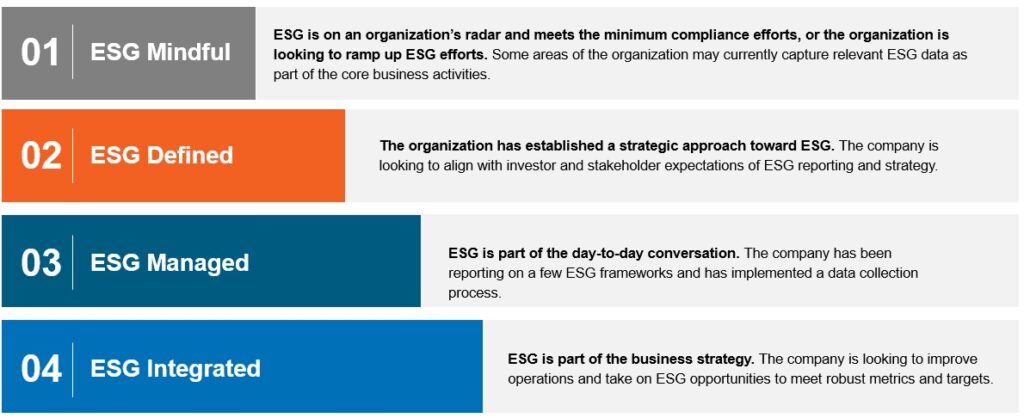To meaningfully advance key environmental, social, and governance (ESG) initiatives – even ahead of forthcoming disclosure requirements – organizations must first assess where they are in their ESG journey. There’s no better way to do that than mapping current efforts against an ESG maturity model. This is square one.
What Is an ESG Maturity Model?
The ESG maturity model is a framework that organizations use to assess their progress in integrating ESG factors into their business practices. Though dependent on the company’s industry, size, goals, and requirements, an ESG maturity model may include multiple stages, ranging from least to most mature. These varying stages help companies gauge their current status and guide them toward achieving higher ESG standards.
ESG Maturity Model Redefined
With more than a decade of experience in sustainability, business transformation, and risk management, ESG leaders at CrossCountry Consulting have designed an ESG maturity model that’s useful for all companies and directly applicable on day one. The four stages of ESG maturity are:

- Stage 1 – ESG Mindful: The organization has started looking into key ESG metrics they may have readily available as part of the organization’s different core areas. At this level, organizations have an awareness of relevant laws, regulations, and stakeholder expectations related to ESG issues that impact them.
- Stage 2 – ESG Defined: The organization has established a strategic ESG approach, and ESG reporting is being explored further by different areas of the business. At this stage, organizations may start to feel pressure from regulators, clients, or investors to start collecting data on identified key risks and opportunities. This involves identifying and prioritizing the ESG issues most relevant to the organization and its stakeholders and establishing clear and measurable goals and targets for improving the organization’s ESG performance. It also includes establishing policies and procedures for monitoring and reporting on progress toward ESG goals and metrics.
- Stage 3 – ESG Managed: The organization has now implemented a robust and systematic ESG strategy in which data is captured consistently across all aspects of the firm. This data is considered part of business operations and strategic decisions. ESG Managed also involves implementing monitoring and reporting processes to track progress toward ESG goals and metrics and to identify emerging ESG risks and opportunities that may require additional attention.
- Stage 4 – ESG Integrated: The organization has fully integrated an ESG strategy, is aware of any potential risks, and is looking to capture opportunities. It’s fully ready to comply with and exceed global regulations using investor-grade ESG-reported data. ESG Integrated also involves integrating ESG strategic goals into the organization’s day-to-day operations, including procurement, supply chain management, and employee training and development, to ensure that ESG considerations are fully embedded in the organization’s culture. At this level, the organization favors a progressive ESG strategy focused on transparency.
Explore expert ESG Reporting solutions that solve real-world problems
Integrate sustainability reporting best practices and build an ESG framework that meets current and emerging regulatory requirements.
Key Components of the ESG Maturity Model
The specific metrics often assessed in an ESG maturity model, again, can vary from company to company, based on business operations and the industries in which they operate. The following factors form a common outline organizations can start with:
- Environmental factors
- Energy consumption reduction.
- Waste management and recycling practices.
- Carbon emissions reduction.
- Water conservation efforts.
- Social factors
- Diversity, equity, and inclusion (DEI) initiatives.
- Labor practices and human rights protection.
- Employee health and safety programs.
- Community and value chain (consumers and supply chain) engagement.
- Governance factors
- Board diversity and composition.
- Transparency in financial reporting.
- Anti-corruption policies.
- Ethics and integrity in decision-making.
Benefits of an ESG Maturity Model
There are many benefits to using an ESG maturity model, including:
- Clear roadmap: By understanding where they sit on the ESG maturity spectrum, companies can assess which key milestones are required to move to the next level.
- Improved ESG performance: By understanding their current maturity level, organizations can develop a plan to set clear metrics and targets to enhance their ESG performance and achieve their ESG goals.
- Increased transparency and accountability: By enhancing their reporting process, organizations can demonstrate their commitment and strategic approach to ESG to their stakeholders.
- Enhanced reputation and brand value: By being seen as a leader in ESG, organizations can attract customers, investors, and top talent.
- Reduced risk: By understanding ESG-related risks, organizations can take proactive mitigation steps, protect their business, and focus their strategy on long-term value creation.
- New opportunities: By understanding the ESG landscape, organizations can position themselves to capitalize on new business opportunities to align with more sustainable market expectations.
Featured Insight
Challenges in ESG Maturity Model Implementation
Merely “defining” ESG programs can impede progress and leave a lot of questions unanswered. Companies must contend with a variety of internal blockers and habits such as:
- Data collection and accuracy: Systematically gathering accurate and comprehensive ESG data across various business units is cumbersome without a cohesive data strategy in place. Inconsistent data can hinder accurate assessments and may translate into greenwashing or reputational risks.
- Complexity of integration: Integrating ESG principles across all levels of an organization requires significant effort and cultural shifts, which can be met with resistance internally and externally.
- Multiple ESG regulatory frameworks: Upcoming localized global ESG reporting standards make prioritization a challenge when deciding how to best allocate internal resources for ESG reporting. This also complicates benchmarking analysis between companies given the difference in scope of ESG disclosures required across different legislations. Most of these regulations use existing well-known frameworks, such as the Taskforce on Climate-Related Financial Disclosures (TCFD), which can smooth companies’ transition into the new regulatory landscape.
- Short-term vs. long-term priorities: Balancing short-term financial goals with long-term ESG objectives can pose dilemmas for decision-makers who must satisfy different audiences, stakeholders, and budget requirements.
To baseline your current ESG posture and meaningfully advance to the next stage of your ESG journey, contact CrossCountry Consulting.
